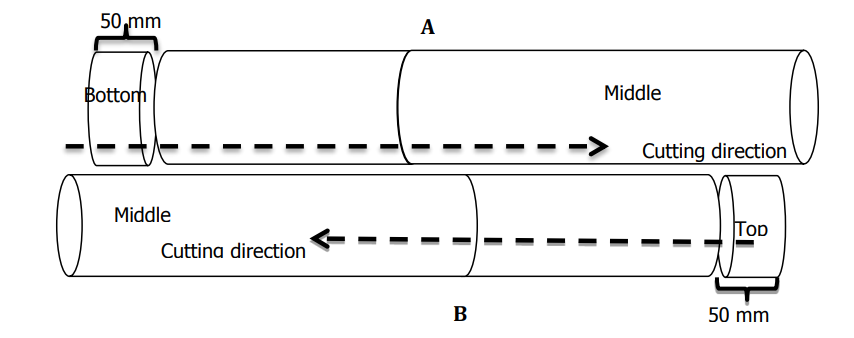Several physical properties of Eucalyptus pellita F. Muell from different provenances and sampling position on tree

Downloads
Downloads
Basri, E. (2011). Kualitas kayu waru gunung (Hibiscus macrophyllus Roxb.) pada 3 kelompok umur dan sifat densifikasinya untuk bahan mebel (Thesis). Yogyakarta: Universitas Gadjah Mada.
Basri, E, Saefudin, Rulliyati, S, & Yuniarti, K. (2009). Drying conditions for 11 potential ramin substitutes. Journal of Tropical Forest Science 21(4): 328-335. doi: https://www.frim.gov.my/v1/JTFSOnline/jtfs/V2 1n4/328-335.pdf.
Bristow, M. (2008). Growth of Eucalyptus pellita in mixed species and monoculture plantations (Thesis). Lismore, New South Wales: Southern Cross University.
BSI. (1957). British Standard 373-157: Methods of Testing Small Clear Specimens of Timber. London.
Cáceres, CB, Hernández, RE, & Fortin, Y. (2017). Shrinkage variation in Japanese larch (Larix kaempferi, [Lamb.]Carr.) progenies/provenances trials in Eastern Canada. Wood Material Science & Engineering: 1-7. doi: 10.1080/17480272.2017.1327460.
Direktur Jenderal Perdagangan Luar Negeri. (2017). Peraturan Kementerian Perdagangan Republik Indonesia 59/M-DAG/PER/8/2017: Penetapan harga patokan eskpor atas produk pertanian dan kehutanan yang dikenakan bea keluar.Jakarta.
Frederick, DJ, Madgwick, HAI, & Oliver, GR. (1982). Wood basic density and moisture content of young Eucalyptus regnans grown in New Zealand. New Zealand Journal of Forestry Science 12(3): 494-500. doi: http://citeseerx.ist.psu.edu /viewdoc /download?doi=10.1.1.705.7772&rep=rep1&type =pdf.
Haggman, H., Sutela, S, & Fladung, M. (2016). Genetic engineering contribution to forest tree breeding efforts. In: Biosafety of Forest Transgenic Trees. Netherland: Springer.
Hii, SY, Ha, KS, Ngui, ML, Ak Penguang, S, Duju, A, Teng, XY, & Meder, R. (2017). Assessment of plantation grown Eucalyptus pellita in Borneo, Malaysia for solid wood utilisation. Australian Forestry 80(1): 26-33. doi: 10.1080/00049158.2016.1272526.
Hopewell, GP, Atyeo, WJ, & McGavin, RL. (2008). Evaluation of wood characteristics of tropical post mid rotation plantation Eucalyptus cloeziana and E. pellita : part (d) veneer and plywood potential. Research Report. Melbourne, Australia: Forest and Wood Products Australia (Unpublished).
Knapic, S, Louzada, JL, Leal, S, & Pereira, H. (2008). Within-tree and between-tree variation of wood density components in cork oak trees in two sites in Portugal. Forestry: An International Journal of Forest Research 81(4): 465-473. doi: 10.1093/forestry/cpn012.
Leksono, B. (2016). Seleksi Berulang pada Spesies Tanaman Hutan Tropis untuk Kemandirian Benih Unggul. Bogor: Badan Penelitian, Pengembangan dan Inovasi.
Lukmandaru, G, Zumaini, UF, Soeprijadi, D, Nugroho, WD, & Susanto, M. (2016). Chemical properties and fiber dimensions of Eucalyptus pellita from the 2nd generation of progeny tests in Pelaihari, South Borneo, Indonesia. Journal of Korean Wood Science Technology 44(4): 571-588. doi: https://www.cabdirect.org/cabdirect/abstract/2 0163271766.
Martawijaya, A, Kartasujana, I, Kadir, K, & Prawira, SA. (2005). Atlas Kayu Indonesia (3rd ed.). Bogor: Center for Forest Products Research and Development.
McGavin, RL, Bailleres, H, Fehrmann, J, & Ozarska, B. (2015). Stiffness and density analysis of rotary veneer recovered from six species of Australian Plantation Hardwoods. Bio Resources, 10(4), 6395 – 6416. doi: HTTP: //ojs.enr.ncsu.edu/index,PhP/BioRes/article/vie w/BioRes_10-4_6394_McGavin_Stiffness_Density_ Analysis_Rotani_Venerr/4272.
Nadalia, D. (2013). Model keterkaitan produksi Eucalyptus pellita dengan karakteristik lahan sebagai dasar penyusunan kriteria kesesuaian lahan (Thesis). Bogor: Institut Pertanian Bogor.
Nirsatmanto, A, Setyaji, T, Sunarti, S, & Kartikaningtyas, D. (2015). Genetic gain and projected increase in stand volume from two cycles breeding program of Acacia mangium. Indonesian Journal of Forestry Research 2(2): 71-79. doi: http://ejournal.forda-mof.org/ejournal litbang / index.php /IJFR /article /view /1521 /1357.
Panshin, AJ, & De Zeeuw, CJ. (1980). Textbook of Wood Technology. New York: McGraw-Hill Book Company.
Quang, TH, Kien, ND, von Arnold, S, Jansson, G, Thinh, HH, & Clapham, D. (2010). Relationship of wood composition to growth traits of selected open-pollinated families of Eucalyptus urophylla from a progeny trial in Vietnam. New Forests 39(3): 301- 312. doi: 10.1007/s11056-009-9172-5.
Setyaji, T, Sunarti, S, & Nirsatmanto, A. (2016). Early growth and stand volume productivity of selected clones of Eucalyptus pellita. Indonesian Journal of Forestry Research 3(1): 27-32. doi: http://ejournal.forda-mof.org/ejournal-litbang /index.php/IJFR/article/view/1578.
Sulichantini, ED. (2016). Pertumbuhan tanaman Eucalyptus pellita F. Muell di lapangan dengan menggunakan bibit hasil perbanyakan dengan metode kultur jaringan, stek pucuk dan biji. Zira'ah 41(2): 269-275. doi: https://ojs.uniska bjm.ac.id/index.php/ziraah/article/view/430.
Yuniarti, K. (2017a). The mechanosorptive behaviour of wood during intermittent drying. Final report: ACIAR project no C2015/250. Research Report. Bogor: Forest Products Research and Development Center. (Unpublished).
Yuniarti, K. (2017b). Pengaruh pohon induk dan posisi sampel pada batang pohon terhadap beberapa sifat fisis mangium (Acacia mangium Willd) usia 4 tahun Paper presented at the Seminar Masyarakat Peneliti Kayu Indonesia (MAPEKI) XX, Denpasar, Bali, 26-29 September.








